-

新人教版高中英语选修2Unit 4 Learning about Language教学设计
This section guides students to pay attention to the typical context of vocabulary use, helps students accumulate vocabulary around the key vocabulary of this unit, and uses the learned words and word chunks in different contexts to deeply understand their meaning and usage, so as to achieve the purpose of review and consolidation.The teaching design activities aim to guide students to pay attention to the typical context in which the target vocabulary is used, as well as the common vocabulary used in collocation, so that students can complete the sentence with correct words. In terms of vocabulary learning strategies, this unit focuses on cultivating students' ability to pay attention to collocation of words and to use word blocks to express meaning.For vocabulary learning, it is not enough just to know the meaning of a single word, but the most important thing is to master the common collocations of words, namely word blocks.Teachers should timely guide students to summarize common vocabulary collocation, such as verb and noun collocation, verb and preposition collocation, preposition and noun collocation, and so on.1. Guide students to understand and consolidate the meaning and usage of the vocabulary in the context, 2. Guide the students to use the unit topic vocabulary in a richer context3. Let the students sort out and accumulate the accumulated vocabulary, establishes the semantic connection between the vocabulary,4. Enable students to understand and master the vocabulary more effectivelyGuiding the Ss to use unit topic words and the sentence patterns in a richer context.

新人教版高中英语选修2Unit 4 Using langauge-Listening教学设计
The theme of the listening section is " talking about scenery and culture along a journey."The part is designed to further lead the students to understand Canadian natural geography and social environment, and integrated into the cultural contrast by mentioning the long train journey from Beijing to Moscow routes. On this basis, the part activates students related travel experience, lets the student serial dialogue, guides the student to explore further the pleasure and meaning of the long journey, and Chinese and foreign cultural comparison.The part also provides a framework for the continuation of the dialogue, which is designed to provide a framework for students to successfully complete their oral expressions, and to incorporate an important trading strategy to end the dialogue naturally.1. Help students to understand and master some common English idioms in the context, and experience the expression effect of English idioms.2. Guide the students to understand the identity of different people in the listening context, and finish the dialogue according to their own experience.3. Instruct the students to use appropriate language to express surprise and curiosity about space and place in the dialogue, and master the oral strategy of ending the dialogue naturally.1. Instruct students to grasp the key information and important details of the dialogue.2. Instruct students to conduct a similar talk on the relevant topic.

新人教版高中英语选修2Unit 5 Learning about Language教学设计
The purpose of this section of vocabulary exercises is to consolidate the key words in the first part of the reading text, let the students write the words according to the English definition, and focus on the detection of the meaning and spelling of the new words. The teaching design includes use English definition to explain words, which is conducive to improving students' interest in vocabulary learning, cultivating their sense of English language and thinking in English, and making students willing to use this method to better grasp the meaning of words, expand their vocabulary, and improve their ability of vocabulary application. Besides, the design offers more context including sentences and short passage for students to practice words flexibly.1. Guide students to understand and consolidate the meaning and usage of the vocabulary in the context, 2. Guide the students to use the unit topic vocabulary in a richer context3. Let the students sort out and accumulate the accumulated vocabulary, establishes the semantic connection between the vocabulary,4. Enable students to understand and master the vocabulary more effectivelyGuiding the Ss to use unit topic words and the sentence patterns in a richer context.Step1: Read the passage about chemical burns and fill in the blanks with the correct forms of the words in the box.

新人教版高中英语选修2Unit 5 Using langauge-Listening教学设计
The theme of this section is to learn how to make emergency calls. Students should learn how to make emergency calls not only in China, but also in foreign countries in English, so that they can be prepared for future situations outside the home.The emergency telephone number is a vital hotline, which should be the most clear, rapid and effective communication with the acute operator.This section helps students to understand the emergency calls in some countries and the precautions for making emergency calls. Through the study of this section, students can accumulate common expressions and sentence patterns in this context. 1.Help students accumulate emergency telephone numbers in different countries and learn more about first aid2.Guide the students to understand the contents and instructions of the telephone, grasp the characteristics of the emergency telephone and the requirements of the emergency telephone.3.Guide students to understand the first aid instructions of the operators.4.Enable Ss to make simulated emergency calls with their partners in the language they have learned1. Instruct students to grasp the key information and important details of the dialogue.2. Instruct students to conduct a similar talk on the relevant topic.Step1:Look and discuss:Match the pictures below to the medical emergencies, and then discuss the questions in groups.

新人教版高中英语选修3Unit 2 Healthy Lifestyle教案
Activity 4: Figuring out the structure and the writing purpose 本活动为实现课时目标2。 1.Read Paragraph 6 and think about its main idea and the writer’s writing purpose. Q1: If you were the author, how would you end your article? “For young people, there is plenty of time to change bad habits. However, there is no “magic pill” or delete button that will help you; you have to think about your bad habits and decide on some changes. You have the power to build a happy and healthy life full of good habits!” Q2: What is Paragraph 6 mainly about? (Possible answer: to appeal to young people including teenagers to change bad habits and live a happy and healthy life.) 2.Think about the writer’s writing purpose and share opinions. Q1: What is the writing purpose? Work in pairs and figure it out. (Possible answer: On the one hand, the passage is written to help teenagers change their bad habits and live a healthy lifestyle. On the other hand, it provides us with a scientific way to identify and analyse our problems objectively, thus strengthening our resolve to tackle the seemingly common yet tough problems in our lives.) 【设计意图】 步骤1旨在预测和验证文章最后一段主要内容,梳理完整的语篇结构,步骤2旨在思考和讨论作者的写作目的。教师也可根据学生课堂反应情况融入对语篇人称多次转换的思考。

新人教版高中英语选修3Unit 5 Poems教案
本单元阅读文本介绍了几种简单的英语诗歌形式,旨在让学生能理解和欣赏英语诗歌的美,包括形式美、内容美、意义美,培养审美情趣,并从作品的意义美中获得积极的人生态度和价值观念启示。 该文本是一则典型的说明性文本,用简单易懂的语言向英语诗歌的初学者们介绍了五种比较简单的英语诗歌形式。文题“A Few Simple Forms of English Poems”是整个文本的核心话题。正文内容共七段,按“总—分—总”建构。第一段为总起段,概述了英语诗歌的创作原因以及主要特点,涉及了形式、内容、意义等方面赏析英语诗歌的几个主要维度;第二段至第六段分别介绍了童谣、清单诗、五行诗、俳句和唐诗五种英语诗歌形式;第七段收尾,鼓励读者尝试英语诗歌创作。 在进行文本教学设计时,要引导学生梳理关于与诗歌要素和诗歌赏析有关的话题类语言,既包括format、rhythm、subject、image等名词,也包括have a strong rhythm、be made up of、contain、consist of、convey这样的动词和动词短语。

新人教版高中英语选修4Unit 2 Iconic Attractions教案
帮助学生通过讨论与对主题的提升,反思自己的旅游方式,以便做出更优化的安排,在今后的旅程中有更多的收益。 Activity 2: Further discussion of the 6 elements above and supplement of more background knowledge 本活动为实现课时教学目标2。 1.Target Q: The writer’s clear target of traveling, meeting the people and experiencing the culture, is closely related to his major in social studies. Then what is social studies? Social studies is a part of a school or college curriculum concerned with the study of social relationships and the functioning of society and usually made up of courses in history, government, economics, civics, sociology, geography, and anthropology. (Dictionary by Merriam-Webster) Reflection: When you go out to travel, what targets do you usually have in mind? 2.Research Q: Suppose you are traveling to Hangzhou during the school holidays, how will you do research on the city? (surf the internet, read books or travel brochures, consult friends, ...) What information will you be interested to know? (location, iconic sites, local cuisines, interesting customs, shopping malls ...) 3.Abandonment To make the most of time, we have to learn to abandon so that we can accomplish our plan. What will you be interested in doing if you go to Hangzhou if you have a week’s time? What if you only have 2 days? 4~5. Venturing & Experiencing Q: What did he venture to do during the trip? What new experiences did he have? In Sydney: attend his first open-air barbecue, enjoy many different but yummy meals In Catherine: observe the life and customs of the aborigines appreciate their music & try the musical instruments: the didgeridoo

新人教版高中英语选修4Unit 4 Sharing教案
【核心素养提升点】学会将抽象信息进行可视化表达,提高信息处理能力和分析、推理等高阶思维品质;在跨文化交际中学会以国际视野接受和包容不同的文化。 5.Read Paragraph 2, draw a mind map and answer the questions. Q1:What did Jo learn about Tombe’s life? Q2:What kind of life do the natives lead? Read paragraph 2-5 and draw a mind-map. (Focus on accommodation, possession, diet and belief) 【设计意图】引导学生利用思维导图和问题链等形式来厘清当地人的生活方式,更好地处理和归纳信息 【核心素养提升点】提高信息处理能力、分析和归纳能力,包容异国文化、扩展国际视野。 6.Read Paragraph 3 and answer the questions. Q1:What was Jo’s feeling upon arriving her own home? Q2:Why would she feel that way? Q3:Do you think “It was such a privilege to have spent a day with Tombe’s family”? 【设计意图】通过提问,让学生理解Jo的苦并快乐的心情,并通过对“It was such a privilege to have spent a day with Tombe’s family”这句话的理解,体验志愿者生活的伟大。 【核心素养提升点】学会对信息的综合和归纳,从而理解作者所表达的观点。 Activity4: Summarize the change of Jo's feelings
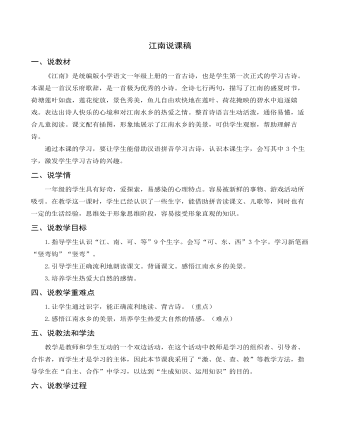
《江南》说课稿
出示贴满荷叶、荷花的小黑板,让学生上台来采摘自己喜欢的荷叶,荷叶背面有本课的生字,该生读对了生字才能摘下荷叶。通过游戏的方式学习生字,增强了趣味性,使学生能积极主动地参与到活动中来,培养学生自主学生的能力。
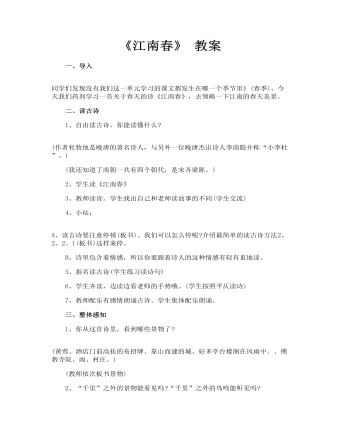
《江南春》 教案
二、读古诗 1、自由读古诗,你能读懂什么? (作者杜牧他是晚唐的著名诗人,与另外一位晚唐杰出诗人李商隐并称“小李杜”。) (我还知道了南朝一共有四个朝代,是宋齐梁陈。) 2、学生读《江南春》 3、教师读诗。学生找出自己和老师读故事的不同(学生交流) 4、小结: A、读古诗要注意停顿(板书)。我们可以怎么停呢?介绍最简单的读古诗方法2、2、2、1(板书)这样来停。 B、诗里包含着情感,所以你要跟着诗人的这种情感有轻有重地读。
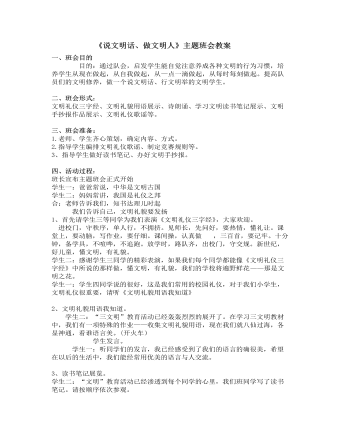
《说文明话, 做文明人》主题班会教案
2、文明礼貌用语我知道。学生二:“三文明”教育活动已经轰轰烈烈的展开了。在学习三文明教材中,我们有一项特殊的作业——收集文明礼貌用语,现在我们就八仙过海,各显神通,看谁语言美。(开火车)学生发言。学生一:听同学们的发言,我已经感受到了我们的语言的确很美,希望在以后的生活中,我们能经常用优美的语言与人交流。3、读书笔记展览。学生二:“文明”教育活动已经渗透到每个同学的心里,我们班同学写了读书笔记。请按顺序依次参观。4、文明手抄报展览。5、为获奖同学颁发奖状。(自制奖状)学生一:我们学了那么多,最终目的就是让我们“说文明话,行文明举,做文明人”。请欣赏〈文明礼仪歌谣〉
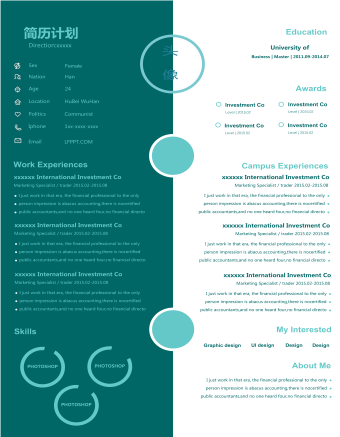
中英文简历
I just work in that era, the financial professional to the onlyperson impression is abacus accounting,there is nocertified publicaccountants,and no one heard four,no financial directo.
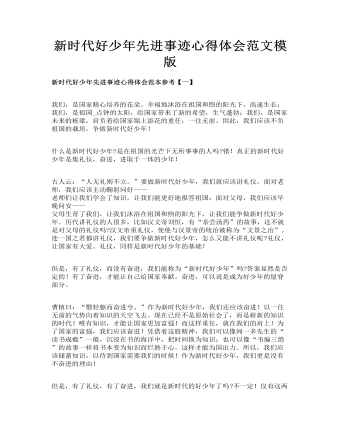
新时代好少年先进事迹心得体会范文模版
古人云:“人无礼则不立。”要做新时代好少年,我们就应该讲礼仪。面对老师,我们应该主动鞠躬问好——老师们让我们学会了知识,让我们能更好地报答祖国;面对父母,我们应该早晚问安——父母生育了我们,让我们沐浴在祖国和煦的阳光下,让我们能争做新时代好少年。历代讲礼仪的人很多,比如汉文帝刘恒,有“亲尝汤药”的故事,这不就是对父母的礼仪吗?汉文帝重礼仪,使他与汉景帝的统治被称为“文景之治”。连一国之君都讲礼仪,我们要争做新时代好少年,怎么又能不讲礼仪呢?礼仪,让国家有大爱。礼仪,同样是新时代好少年的基础!
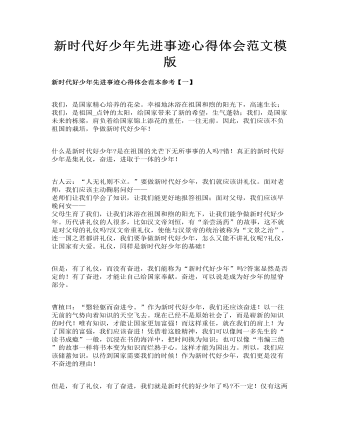
新时代好少年先进事迹心得体会范文模版
古人云:“人无礼则不立。”要做新时代好少年,我们就应该讲礼仪。面对老师,我们应该主动鞠躬问好——老师们让我们学会了知识,让我们能更好地报答祖国;面对父母,我们应该早晚问安——父母生育了我们,让我们沐浴在祖国和煦的阳光下,让我们能争做新时代好少年。历代讲礼仪的人很多,比如汉文帝刘恒,有“亲尝汤药”的故事,这不就是对父母的礼仪吗?汉文帝重礼仪,使他与汉景帝的统治被称为“文景之治”。连一国之君都讲礼仪,我们要争做新时代好少年,怎么又能不讲礼仪呢?礼仪,让国家有大爱。礼仪,同样是新时代好少年的基础!
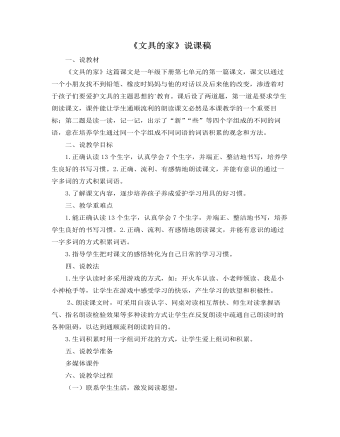
部编人教版一年级下册《文具的家》说课稿
一、说教材《文具的家》这篇课文是一年级下册第七单元的第一篇课文,课文以通过一个小朋友找不到铅笔、橡皮时妈妈与他的对话以及后来他的改变,渗透着对于孩子们要爱护文具的主题思想的`教育。课后设了两道题,第一道是要求学生朗读课文,课件能让学生通顺流利的朗读课文必然是本课教学的一个重要目标;第二题是读一读,记一记,出示了“新”“些”等四个字组成的不同的词语,意在培养学生通过同一个字组成不同词语的词语积累的观念和方法。二、说教学目标1.正确认读13个生字,认真学会7个生字,并端正、整洁地书写,培养学生良好的书写习惯。2.正确、流利、有感情地朗读课文,并能有意识的通过一字多词的方式积累词语。3.了解课文内容,逐步培养孩子养成爱护学习用具的好习惯。
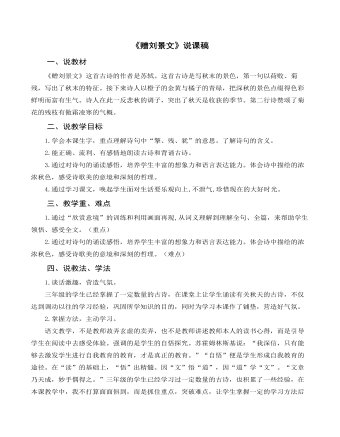
部编人教版三年级上册《古诗三首 赠刘景文》说课稿
一、说教材《赠刘景文》这首古诗的作者是苏轼。这首古诗是写秋末的景色,第一句以荷败、菊残,写出了秋末的特征。接下来诗人以橙子的金黄与橘子的青绿,把深秋的景色点缀得色彩鲜明而富有生气。诗人在此一反悲秋的调子,突出了秋天是收获的季节。第二行诗赞颂了菊花的残枝有傲霜凌寒的气概。二、说教学目标1.学会本课生字,重点理解诗句中“擎、残、犹”的意思。了解诗句的含义。2.能正确、流利、有感情地朗读古诗和背诵古诗。3.通过对诗句的诵读感悟,培养学生丰富的想象力和语言表达能力。体会诗中描绘的浓浓秋色,感受诗歌美的意境和深刻的哲理。4.通过学习课文,唤起学生面对生活要乐观向上,不泄气,珍惜现在的大好时光。三、教学重、难点1.通过“欣赏意境”的训练和利用画面再现,从词义理解到理解全句、全篇,来帮助学生领悟、感受全文。(重点)2.通过对诗句的诵读感悟,培养学生丰富的想象力和语言表达能力。体会诗中描绘的浓浓秋色,感受诗歌美的意境和深刻的哲理。(难点)
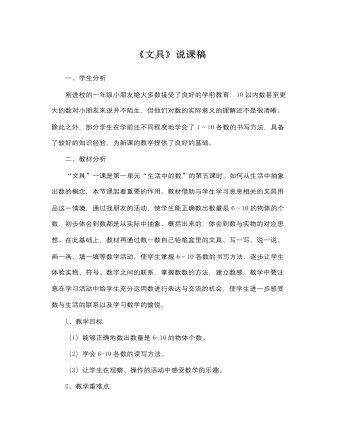
北师大版小学数学一年级上册《文具》说课稿
一、学生分析刚进校的一年级小朋友绝大多数接受了良好的学前教育,10以内数甚至更大的数对小朋友来说并不陌生,但他们对数的实际意义的理解还不是很清晰。除此之外,部分学生在学前还不同程度地学会了1~10各数的书写方法,具备了较好的知识经验,为新课的教学提供了良好的基础。二、教材分析“文具”一课是第一单元“生活中的数”的第五课时。如何从生活中抽象出数的概念,本节课起着重要的作用。教材借助与学生学习息息相关的文具用品这一情境,通过找朋友的活动,使学生能正确数出数量是6~10的物体的个数,初步体会到数都是从实际中抽象、概括出来的,体会到数与实物的对应思想。在此基础上,教材再通过数一数自己铅笔盒里的文具、写一写、说一说、画一画、填一填等数学活动,使学生掌握6~10各数的书写方法,逐步让学生体验实物、符号、数字之间的联系,掌握数数的方法,建立数感。
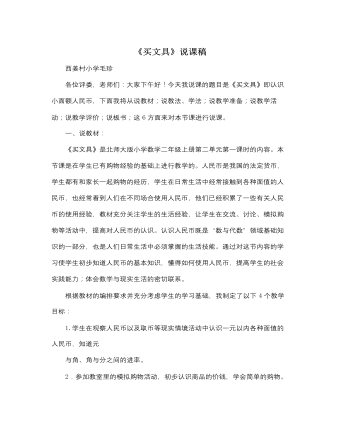
北师大版小学数学二年级上册《买文具》说课稿
(一)、情境导入通过播放笑笑和淘气在文具店购买文具活动的视频片段,唤起学生已有的知识和经验,使学生想到“买东西要使用人民币”。又因为二年级孩子年龄较小,社会经验不足,上市场、超市购物的机会也少,对人民币只是初步的认识,对于要用到钱才能买到东西这一朴素的等价交换的原则只有初步的意识。所以借此机会激发学生想不想和笑笑、淘气一起到文具店里去购买文具呢?从而引出课题:买文具。(二)、认识小面额人民币学生在生活中经常看到人民币,有时还使用人民币,因此我首先让学生互相交流:你知道有哪些面值的人民币?根据学生的回答,老师有序地进行板书:1角、2角、5甬1元、2元、5元10元、20元、50元100元在这一环节中我仅作为引导者,引导学生相互交流,在师生互动中完成对已有知识经验的归纳与延伸,通过小组合作,互相交流,让全体学生参与学习过程,在学习过程中有意识培养学生细心观察、仔细倾听、善于总结的良好习惯。
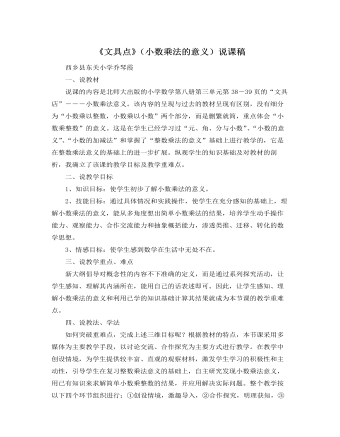
北师大版小学数学三年级上册《文具点》说课稿
(三)深化运用,巩固新知在这个环节,我设计四组闯关题。第一关是试一试:①买3支铅笔需要多少元?②买两把直尺需要多少元?这关是模仿性练习,让学生运用已学的数学知识解决实际问题。第二关是说一说,在学生初步感知了小数乘法的意义后,我给出了6个算式,让学生说一说他们所表示的意义。第三关是填一填,即根据加法算式写乘法算式和根据乘法算式写加法算式,这两关是提高性练习。第四关是涂一涂,即根据算式涂涂得出结果。是为了进一步加深学生对小数乘法意义的理解。第五关是想一想:0.3×4=0.6,4×0.3=?这关是深化性练习,一是让学生明白整数乘法的交换律在小数乘法中同样适用,二是让学生体会一个整数乘小数的意义也是求几个几是多少。第六关是两组口算练习。第七关是两道解决问题。主要是在学生理解小数乘整数的意义的基础上复习以前所学的数量关系。
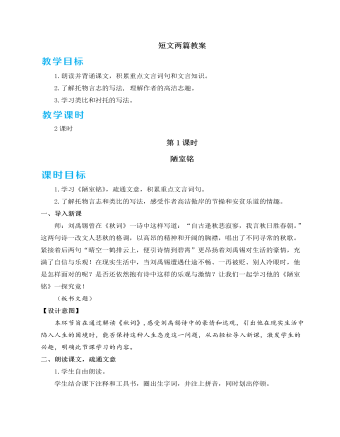
人教部编版七年级下册短文两篇教案
本课由两篇短小易懂、文辞优美的文言文组成,针对这一特点,本课设计分为两课时,先通过教读《陋室铭》学习托物言志,再通过自主学习《爱莲说》来理解托物言志,采用先教后学的模式进行教学。在《陋室铭》教学中,设计“朗读”“品读”“析读”“联读”四个环节,逐层深入,在读中明特点,读中明志趣,读中析写法,读中悟主旨。以诗人积极的人生态度、豁达的胸襟为行文线索,从文本出发,深入解读文本,让学生逐步理解诗人面对苦难仍能坚守自我的人生态度和高尚情操,同时让学生学习托物言志的手法,了解这类文章的特点。《爱莲说》采取自主学习的模式,分两步进行。先运用上节课的四个环节,在老师的指导下,进行自主合作学习。老师给予学生自学方法,并适时引导,让学生逐步完成学习任务,以此理解文章内容,提高学生自主学习文言文的能力;再采用竞赛的方式展示学习成果,以几个不同形式的比赛,来激发学生的学习兴趣,让学生在竞赛中夯实文言文的基础知识,在竞赛中加深对文章的理解,学会探究。本课整个教学设计思路清晰,教学方法可操作性强。
